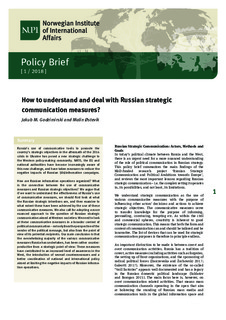| dc.contributor.author | Østevik, Malin | |
| dc.contributor.author | Godzimirski, Jakub M. | |
| dc.date.accessioned | 2018-03-14T18:01:06Z | |
| dc.date.available | 2018-03-14T18:01:06Z | |
| dc.date.created | 2018-03-14T13:15:42Z | |
| dc.date.issued | 2018 | |
| dc.identifier.uri | http://hdl.handle.net/11250/2490552 | |
| dc.description.abstract | Russia’s use of communicative tools to promote the
country’s strategic objectives in the aftermath of the 2014
crisis in Ukraine has posed a new strategic challenge to
the Western policy-making community. NATO, the EU and
national authorities have become increasingly aware of
this new challenge, and have taken measures to reduce the
negative impacts of Russian (dis)information campaigns. | nb_NO |
| dc.language.iso | eng | nb_NO |
| dc.publisher | Norsk utenrikspolitisk institutt | nb_NO |
| dc.relation.ispartof | NUPI Policy Brief | |
| dc.relation.ispartofseries | NUPI Policy Brief;2018-01 | |
| dc.rights | Navngivelse-Ikkekommersiell-DelPåSammeVilkår 4.0 Internasjonal | * |
| dc.rights.uri | http://creativecommons.org/licenses/by-nc-sa/4.0/deed.no | * |
| dc.title | How to understand and deal with Russian strategic communication measures? | nb_NO |
| dc.type | Research report | nb_NO |
| dc.description.version | publishedVersion | nb_NO |
| dc.source.pagenumber | 4 | nb_NO |
| dc.source.issue | 1 | nb_NO |
| dc.identifier.cristin | 1572792 | |
| cristin.unitcode | 7471,11,0,0 | |
| cristin.unitname | Russland, Eurasia og Arktis | |
| cristin.ispublished | true | |
| cristin.fulltext | original | |

